28 August 1778 Friday
. . . . . .
Artifacts of the Bianconi vs Piranesi 'Circus of Caracalla' affair 1772-1789
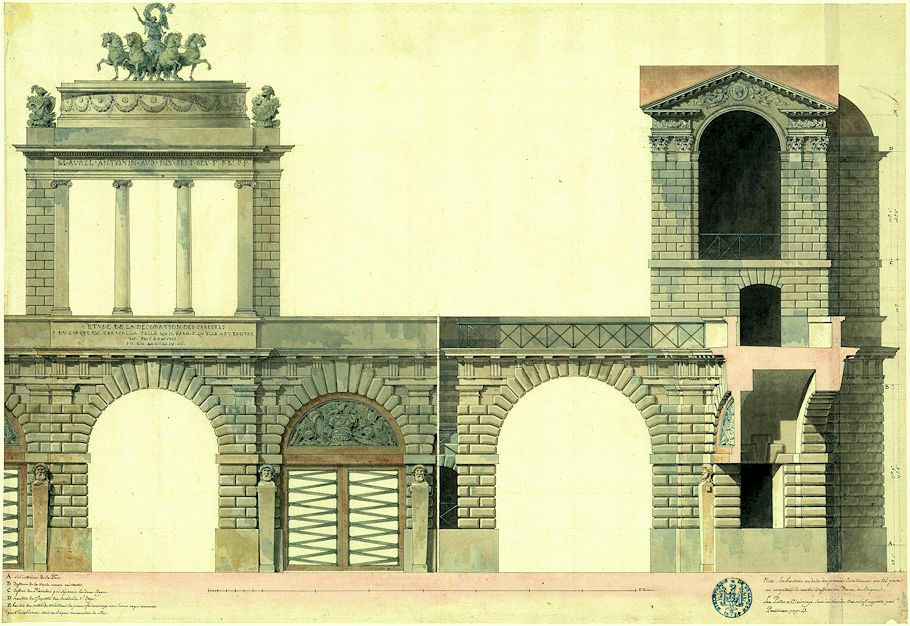
Pierre-Adrien PÔris 1804
48 y.o. Francesco Piranesi 1806
Le AntichitÓ della Magna Grecia Parte II
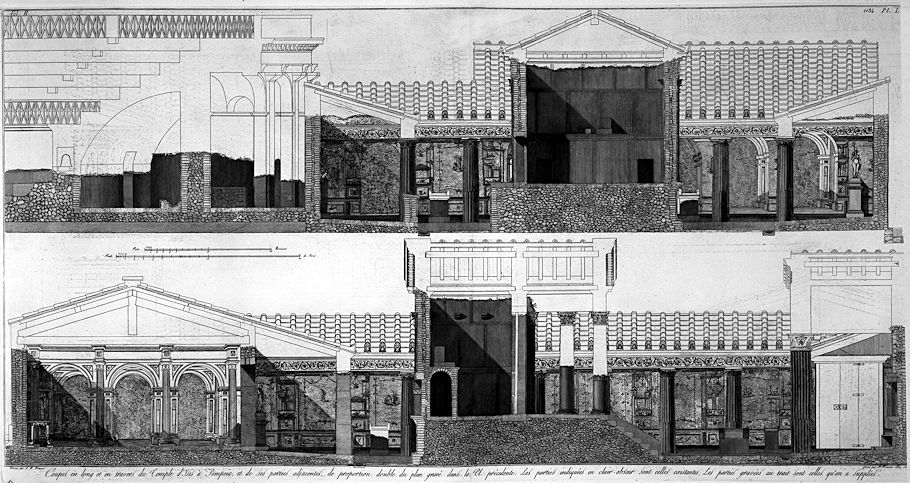
Longitudinal and transverse sections of the Temple of Isis at Pompe´a, and of its adjacent parts, of double proportion of the plan engraved in the preceding Pl. The parts shown in chiaroscuro are those that exist; The line-engraved parts are those that have been supplemented.
Drawn by G.B. Piranesi
Engraved by F. Piranesi Year 1806
28 August 1812 Friday
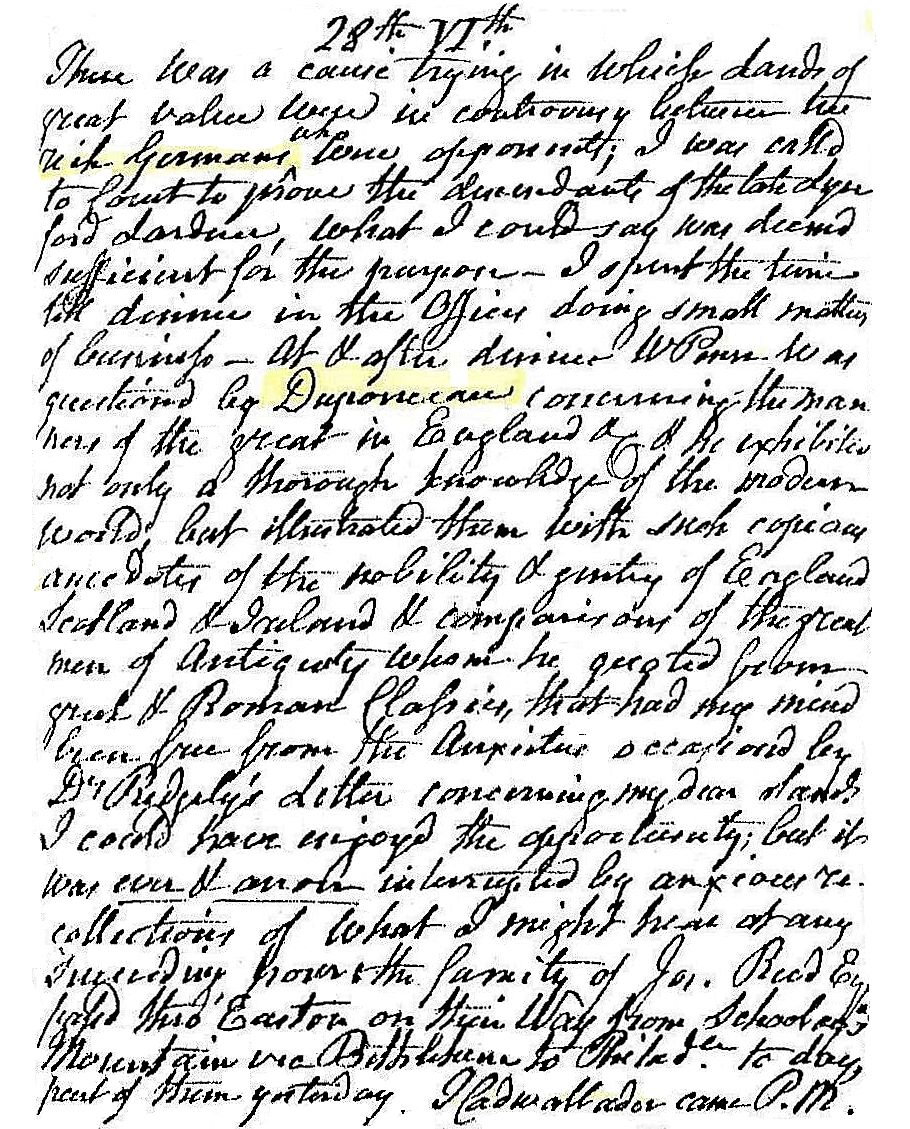
There was a cause[?] trying in which lands of great value were in controversy between two rich Germans who were opponents; I was called to Court to prove[?] the descendants of the late Lyerford[?] Lardner. What I could say was deemed sufficient for the purpose. I spent the time till dinner in the office doing small matters of business. At and after dinner W Penn was questioned by Duponceau concerning the manners of the great in England and he exhibited not only a through knowledge of the modern world, but illustrated them with such copious anecdotes of the nobility and gentry of England, Scotland and Ireland and comparisons of the great men of antiquity whom he quoted from Greek and Roman classics, that had my mind been free from the anxieties occupied by Dr. Ridgely's letter concerning my son Samuel, I could have enjoyed the opportunity; but it was ever and anon interrupted by anxious recollections of what I might hear at any s......[?] hour. The family of Jos. Reed Esq[?] passed through Easton on their way from Schoolog's[?] Mountain via Bethlehem to Philadelphia today, p...[?] of them yesterday. T Cadwallader came P.M.
28 August 1977
Sunday Ostia Antica [I liked the ruined port town a lot, but, toward the end of the visit around noon, I started feeling unwell, so I went back to Rome and stayed in bed until the next morning, and then I'd see how I feel.]
28 August 2001
Re: Prisca, Eutropia and Valeria
Thank you for supplying the Lactantius source regarding the (textually slim) possibility that Prisca and Valeria were Christian believers during the persecution of 303-305 or in the following years of their lives. While textual evidence is most often the cornerstone of historical veracity, there are also many other factors that relate 'history'. For example, you mention some reasons that may have compelled Eutropia to 'convert' to Christianity by 324 or soon thereafter. A question I ask is: how might Eutropia (and Helena for that matter) have reacted when she learned of the dire fate of Prisca and Valeria? Prisca and Eutropia no doubt knew each other quite well, perhaps just as well as their respective husbands Diocletian and Maximian knew each other. The violent deaths of Prisca and Valeria may well have affected Eutropia greatly. Perhaps this is the reason why she later decided to "embrace the faith of her son-in-law," or perhaps this is one of the factors that further resolved Eutropia's own faith. The point being that either scenario is plausible depending almost only on individual point of view.
As to lack of other textual evidence regarding the possible Christian beliefs of Prisca and Valeria, I am quickly reminded of the recent discussion here on damnatio memoriae and the notion of historical 'silence' as well. Last night I was reading H.W. Bird's Introduction to the Breviarium ab Urbe Condita of Eutropius, and was intrigued to learn that Christianity was virtually not at all mentioned in this abbreviated history of Rome and its rulers, even though the text was dedicated to and written for the Christian Emperor Valens in 369. Did Eutropius omit Christian details because he himself was not a Christian? Having been close to the emperor Julian (the Apostate), however, the rise (and threat) of Christianity to the Hellenic status quo was surely not unknown to Eutropius. The Breviarium of Eutropius is a perfect example of textual history that purposefully omits much of what (really) happened.
[As an aside, last summer (15 August to be exact) I thought of a great title for a book, but alas I wasn't sure what the content would or could be. Given what appears to be my approach toward (writing) history, I think I could now eventually fill a book entitled Learning from Lacunae: a progressive inquiry of the acquisition of knowledge via reflection on what is not there.]
Putting the issue of Prisca and Valeria in the background for a while, the most widely accepted reason that any Imperial of the early 3rd century became an avowed Christian is due largely to augury, specifically Constantine's report that there was a 'sign' in the sky 27 October 312, the night before the Battle of the Milvian Bridge. While augury is for the most part considered a Pagan practice, it is nonetheless exactly a type of augury that Constantine professed to base his faith upon. That augury was still very much practiced throughout the Empire in the early 3rd century is well documented, for example, Maxentius went into battle at the Milvian Bridge in confidence against Constantine because 28 October 312 was exactly the sixth anniversary of Maxentius' raise to power (28 October 306). Some historians write that Maxentius' augers foresaw a great victory, but unfortunately it turned out not to be his own.
I have to admit that 'augury' has very much to do with my investigation into the life of Helena. Since 1 April 1999 (Holy Thursday that year, and the fifth anniversary of the death of a close architect/friend of mine; 1 April 1994 was Good Friday) there have been repeated occurrences that I could call 'signs', however, for reasons of objectivity, I choose to first off accurately record the occurrences (e.g., 'calendrical coincidences'), and thus treat the occurrences as their own history. If I am able to write anything with complete veracity, it is the story of how Helena (very unexpectedly) became a part of my life. Is it significant that within the first week of writing EPICENTRAL that Steven Izenour, co-author of Learning from Las Vegas died on 21 August 2001 (the same date as my grandmother's death 13 years ago, and the birthday of my nephew/godson also 13 years ago)? Or that a Vietnamese nun was brutally attacked early 23 August 2001 while on her way to Mass at St. Helena's Church in Olney, Philadelphia? (The nun was hit on the head with a hammer, but not severely injured, and St. Helena's is the Catholic parish next to my own; I live in (the exact same valley of) St. Ambrose Parish, Philadelphia. And the relationship between Ambrose and Helena certainly hasn't escaped me). The only real significance of all this is that it is indeed all true, which is a whole lot more than can be said of many 'histories'.
Getting back to serious history then, it is interesting to note that Fausta is named within the Breviarium of Eutropius, specifically her disclosure of Maximian's plot against Constantine (Book 10, section 3). Comparatively, the death of Crispus is mentioned (10:6) but only that Constantine "killed his son"--the name of Crispus is omitted. This appears to be a sure sign as to the continuance of the damnatio memoriae of Crispus, but why then is Fausta's name written in the same text if she also suffered damnatio memoriae. Again, is there then a special significance to the 'Helena/Fausta' palimpsest of CIL X 678?


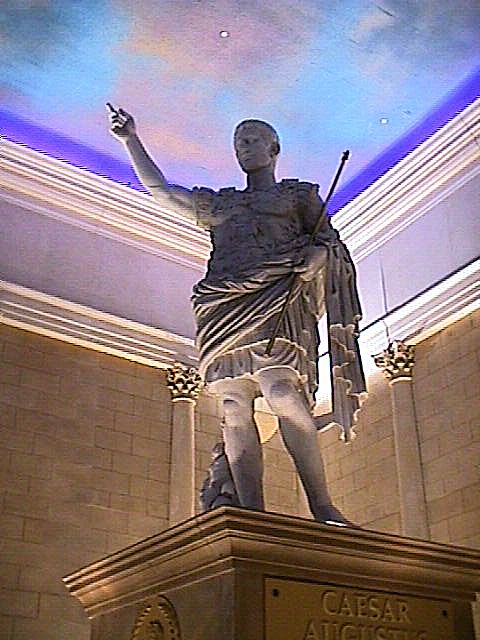
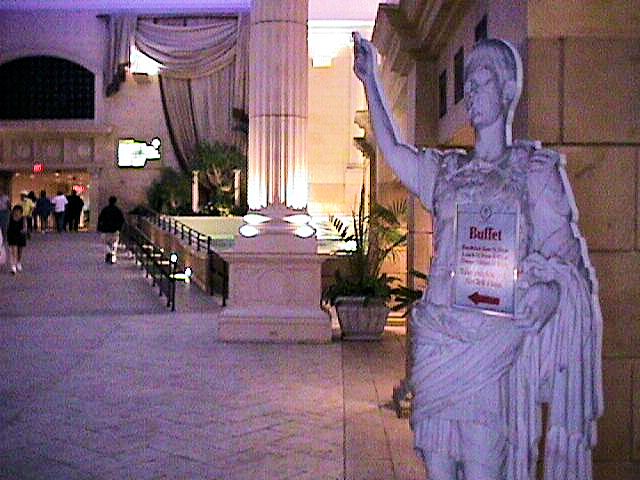
Caesar's Palace Atlantic City
28 August 2003
Re: closing on Mars
Last night I began to wonder/question when exactly the planet Mars was first named (for) Mars. Moreover, what did/do other (than Western) cultures name the fourth planet of our solar system? According to Encyclopedia Britannica, the Greeks associated the fourth planet with Ares (also a god of war) supposedly because of its red (i.e., danger) color.
When Mars is in opposition, like now, it is the fourth brightest heavenly body (relative to Earth viewing), being surpassed only by the sun, the moon, and the planet Venus. When Mars is not in opposition, the planet Jupiter is the fourth brightest heavenly object (relative to Earth viewing). Perhaps the ancients (at least the Greeks and the Romans) saw this periodic exchange of 'power' between Jupiter and Mars as indicative of the periodic power of war over even the most high. Fortunately, love, i.e. Venus, is never outshone by either Mars or Jupiter.
28 August 2021
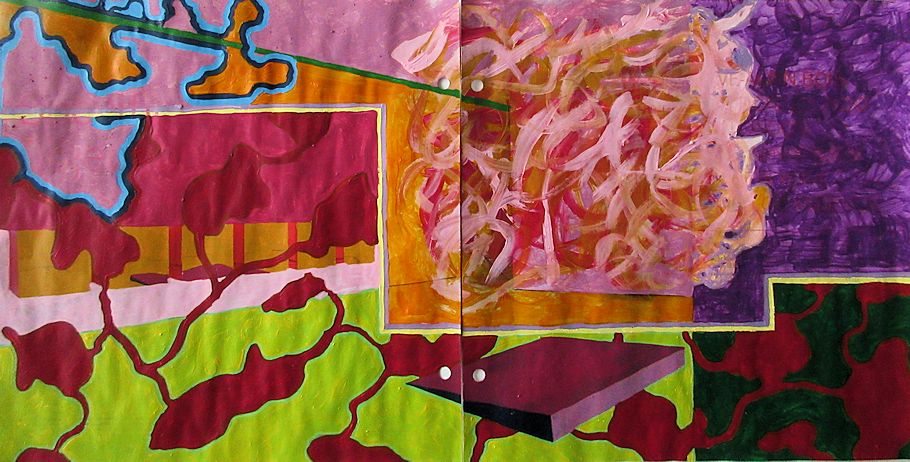
28 August 2023 Monday
Many memories have passed through my mind over the last few days. When thinking back to the 14 May 1999 discovery of two different versions of the Ichnographia Campus Martius at Fine Arts Library of the University of Pennsylvania--the Furness library--my numerous other memories of the University of Pennsylvania's Graduate School of Fine Arts come into the picture as well. I was employed by the Dean's Office of the Graduate School of Fine Arts for almost two years, 1985-87. I was there because I was the only architect in the city that knew how to fully operate and manage the Graduate School's newly installed Intergraph computer-aided drafting and design--CADD--system. I ran a small CADD service business for the Graduate School to help offset the cost of the system. I initially answered to the Vice Dean, Ann Strong, of the Graduate School of Fine Arts, and later answered to the University's Vice Provost of Computing, Dr. Stonehill. Academically, there was no involvement on my part with the Graduate School of Fine Arts, but I did have singular encounters with Adele Santos, Marco Frascari, David Leatherbarrow, Peter McCleary, and even a completely unexpected intimate face-to-face with Joseph Rykwert. At that time, at least, most on this list had a thorough dislike and ignorance of CADD.
The most significant work I performed at the GSFA was the generation of 3D CADD model of Center City Philadelphia for the Philadelphia City Planning Commission. This led to an (often aired) 5 minute Spotlight on local PBS station WHYY TV12, and subsequently being one of the authors and architects featured in the Pennsylvania Academy of Fine Arts' Drawing Toward Building exhibition. All that happened shortly before I turned thirty.
I met many people from all over the place, and even some from very high places. Apparently, EstÚe Lauder was at the same Trustee's Luncheon that I too was invited too--turned out the new woman in charge of Development (fund raising) really liked me and simply added my name to the guest list. And one day the architect of China's Great Hall of the People on Tiananmen Square was brought in to look at the Intergraph system, and I gave him a quick demonstration of how it all worked. I'm not entirely sure anymore, but I don't think he spoke any English.
next: A meeting with Dean Emeritus G. Holmes Perkins in the Rare Book Room of the Furness library, plus coming up with a project working in conjunction with the Louis I. Kahn Collection within the Architectural Archives of the University of Pennsylvania (also in the Furness Library), and getting permission to do it.
|